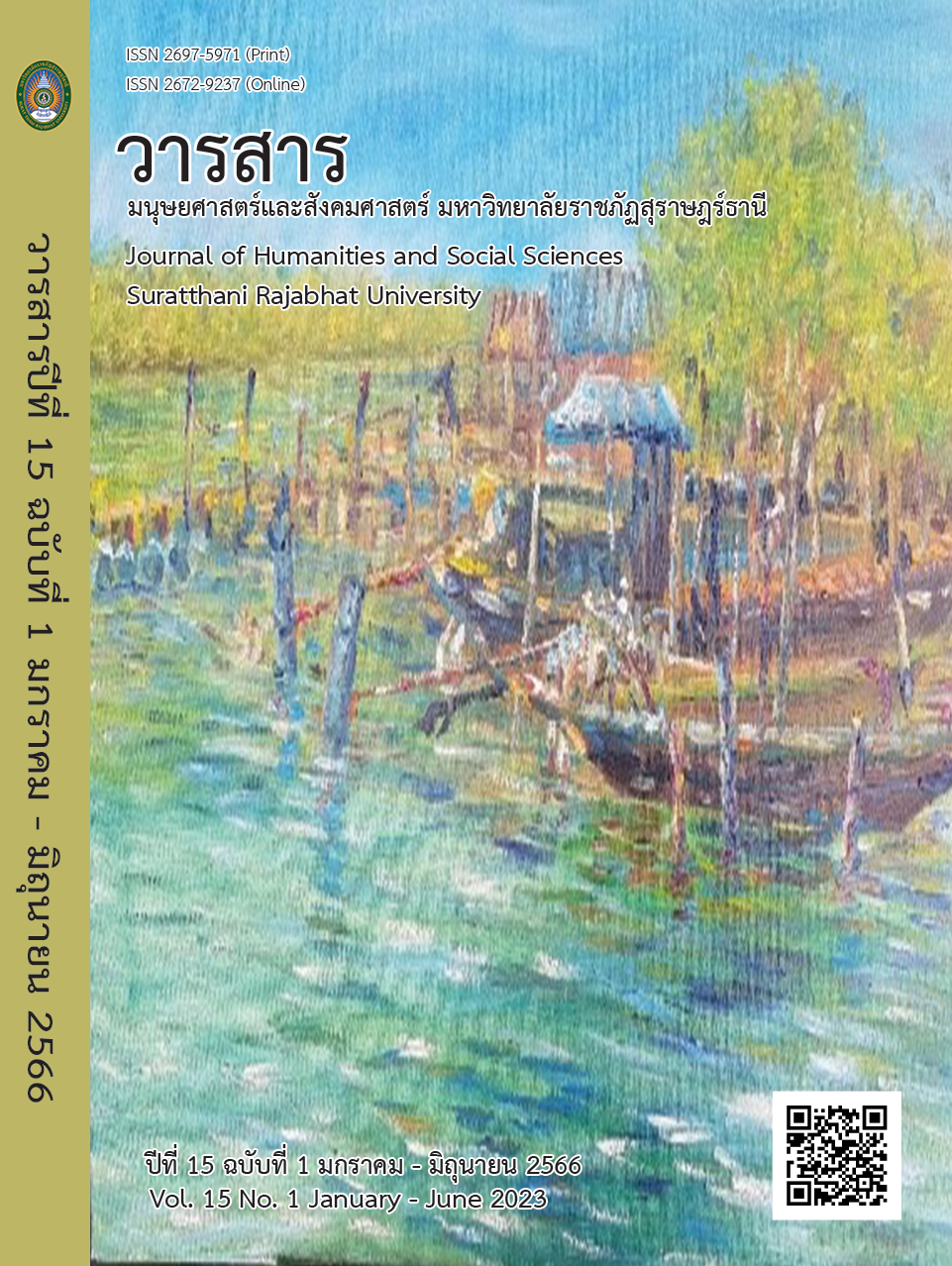Telaga Batu Inscription: Belief of Aristocracy Reflected in Form and Essence
Main Article Content
Abstract
The Telaga Batu inscription was one of the primary inscriptions of Indonesia, inscribed at the beginning of the founding of the Sriwijaya Empire. This article aimed to investigate the aristocracy's beliefs as reflected in the form and essence of the inscriptions. The results of the study were as follows: The study's results of analyzing the form of the Telaga Batu inscription led to the assumption that the form of the Telaga Batu inscription was built for ceremonial purposes related to the ceremony of carrying holy water to show loyalty to the king. The seven serpent-head sculptures at the top of the inscription were one of the symbols of power. According to Hindu
beliefs, the form indicated the king's belief in fictitious deities' merit and royal powers. According to the study's findings, analyzing the contents of the
Telaga Batu inscription revealed that the essence of the inscription indicated cursing those who thought and acted as if they were betraying the king.
The inscription reflected concepts and beliefs about the royal power of the king's customs towards those under his rule at all levels. They used the curse, which was believed to have supernatural powers, to terrify those who
betrayed them.
The study results showed that this inscription reflected beliefs in many dimensions, including religion, power, prestige, the merit of the king, and the supernatural power of the curse. Therefore, it could be considered that the Telaga Batu inscription was a communicative tool designed and carved with words as one element in building faith and maintaining the royal power of the king at the early age of the establishment of this
kingdom.
Article Details

This work is licensed under a Creative Commons Attribution-NonCommercial-NoDerivatives 4.0 International License.
All published manuscripts have been verified by peer-peer professors in the fields of humanities and social sciences. Reprinting of the article must be authorized by the editorial staff.
References
กรมส่งเสริมการส่งออก. (2555). คู่มือการค้าและการลงทุนสาธารณรัฐอินโดนีเซีย.
กรุงเทพฯ: กรมส่งเสริมการส่งออก กระทรวงพาณิชย์.
กัญญารัตน์ เวชศาสตร์. (2559, มกราคม-เมษายน). มโนทัศน์เรื่องนาคของชนชาติไท.
Veridian E-Journal, Silpakorn University ฉบับภาษาไทย สาขามนุษยศาสตร์
สังคมศาสตร์ และศิลปะ, 9(1), 1099-1116.
ซี. แมรี เทิร์นบูลล์. (2540). ประวัติศาสตร์มาเลเซีย สิงคโปร์ และบรูไน [A History of
Malaysia, Singapore and Brunei] (ทองสุก เกตุโรจน์, ผู้แปล). กรุงเทพฯ:
กระทรวงศึกษาธิการ.
ลักษมณ์ บุญเรือง. (2561, มกราคม-กันยายน). หลักฐานเกี่ยวกับวัฒนธรรมศรีวิชัยใน
คาบสมุทรภาคใต้. วารสารข่วงผญา, 13(1), 132-140.
ศานติ ภักดีคำ. (2550). ความสัมพันธ์วรรณคดีไทย-เขมร. กรุงเทพฯ: อมรินทร์.
อิมรอน ซาเหาะ, และ ยาสมิน ซัตตาร. (2559). แนวคิดสันติภาพและการจัดการความขัด
แย้งในอิสลาม. Kasetsart Journal of Social Sciences, 37(3), 333-344.
Abdur, R. (2017). The Kingdom of Sriwijaya in The Development
of Islamic Civilization and The Economy on Nusantra Before 1500
AD. Journal old Malay Islamic Studies, 1(1), 39-49.
Alnoza, M. (2020). Serpent Sculpture on Telaga Batu Inscription: An Interpretation
Based on Peirce’s Semiotic Approach. Berkala Arkeologi, 40(2), 267-
Boulay, R.A. (1999). Flying Serpents and Dragons: The Story of Man’s
Reptilian Past. California: The Book Tree.
Coedès, G. (2014). Prasasti berbahasa Melayu Kerajaan Sriwijaya. Jakarta:
Komunitas Bambu.
Coedès, G. & Damais, L. Ch. (1992). Sriwijaya-History, Religion & Language of
an Early Malay Polity. Kuala Lumpur: Art & Printing Sdn.
De Casparis, J.G. (1956). Selected Inscriptions from the 7th to the 9th
Century A.D. Bandung: Masa Baru.
Gunawan, K. (2009, 26 August). Srivijaya_Empire.JPG. https://en.wikipedia.
org/wiki/ Srivijaya#/media/File:Srivijaya_Empire.svg
Gunawan, K. (2010, 24 August). Telaga_Batu_inscription.JPG. https://
worddisk.com/wiki/ Telaga_Batu_inscription/
Hannigan, T. (2015). A Brief History of Indonesia. Sultans, Spices, and
Tsunamis. The Incredible Story of Southeast Asia's Largest Nation.
Tokyo: Tuttle Publishing.
Herman, K. (1993). “Kadatuan Sriwijaya”– Empire or Kraton of Sriwijaya M.A.
Reassessment of the Epigraphical Evidence. l'École française
d'Extrême-Orient, 80(1), 159-180.
Izza, N. A. (2019). Sapatha Prasasties of Sriwijaya: Study of Foucault Panoptisism.
Jurnal Ilmu Humnicra, 3(1), 110-123.
Kartakusuma, R. (1993). Dapunta Hiyam Sri Jayanasa: Kajian Atas Makna Dari
Prasasti Telaga Batu. Dalam Amerta, 13(1), 17-32.
Leyten, J. (2017). The Capital of Sriwijaya. Sejarah Lengkap Kerajaan Mataram
Islam. Academia Accelerating the world’s research. https://www.
academia.edu/34273392/ The_Capital_of_Srivijaya
Marcus, M. F. (1965). Buddha Sheltered by Mucalinda. The Bulletin of the
Cleveland Museum of Art, 52(7), 185- 193.
Sepriady, J. (2020, 14 June). TELAGA BATU BUKTI KERAJAAN SRIWIJAYA ITU
ADA || VLOG PESERTA DIDIK SMA MAITREYAWIRA PALEMBANG.
https://www.youtube.com/watch?v=GzUhluFdG4I&t=2s
Utomo, B. B. & Soejatmi, S. (2009). Treasures of Sumatra. Jakarta: Direktorat
Jenderal Kebudayaan.
XA-1 Kanisius'22. (2020, 17 February). Prasasti Telaga Batu. https://www.
youtube.com/watch?v= 37mDXKPpb-k.
บุคลานุกรม
กุสุมา รักษมณี (ผู้ให้สัมภาษณ์) ณภัทร เชาว์นวม (ผู้สัมภาษณ์). ณ ห้องสนทนาเฟซบุ๊ก.
เมื่อวันที่ 25 เมษายน 2565.
ณัฐพล จันทร์งาม (ผู้ให้สัมภาษณ์) ณภัทร เชาว์นวม (ผู้สัมภาษณ์). ณ ห้องสนทนาเฟซบุ๊ก.
เมื่อวันที่ 5 กุมภาพันธ์ 2565.


